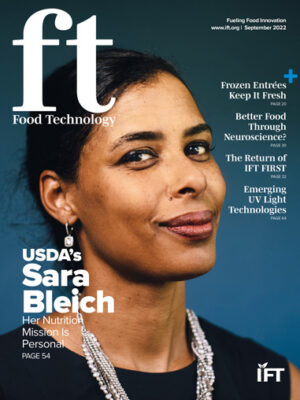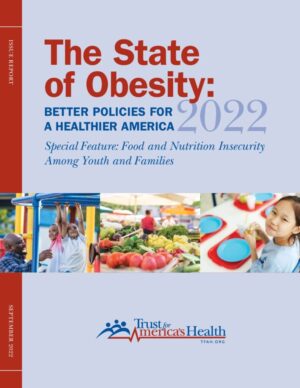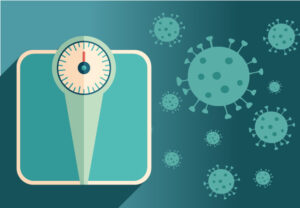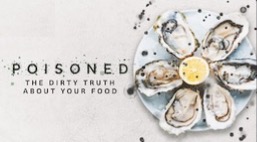
Obesity and food science
As we finish our section on obesity, I alert you to this terrific article in Food Technology magazine from 2022. It describes the personal journey of Dr. Sara Bleich, a professor of Professor of Public Health Policy at Harvard and the former Director of Nutrition Security and Health Equity at the USDA.
In this article, Dr. Bleich discusses many of the same issues we talked about – childhood obesity, the role of communities, and how obesity affects certain populations more than others. She also touches on one of themes of this unit – how the food industry can partner with the USDA and public health agencies to improve the food supply.
She also used the same example as I did in class about the calorie equivalents between a bottle of pop and 5 miles of walking.
What is especially inspiring about this article, however, is that while Dr. Bleich may have earned degrees from Harvard and Columbia, when she was a child, her family received SNAP and WIC assistance.
Image from www.ift.org

The Obesity Neighborhood
Public health authorities have claimed that environment contributes to the obesity epidemic. For example, there are several studies (here and here) where researchers showed a high correlation between the number of fast-food restaurants and the obesity prevalence. Here is another not-so-surprising study from 2021 that concluded proximity (1-3 km) of fast-food restaurants to pre-school aged kids was also a factor. Indeed, the closer the kindergarten school was located to Western-type fast food restaurants, the higher was the obesity rate.
The researchers concluded that policymakers should consider regulating how fast-food restaurants are distributed near K-12 schools. You can even extend that suggestion to college campuses, where these restaurant are widely present, even in the student unions. From your experience, do you think this policy (restricting access) would be effective?

Dorm Food in 2023
One of the most noticeable changes on college campuses over the past generation has been the availability and quality of foods served in dormitory dining halls and cafeterias. Back in the day, dorm food was very institutional and very boring. Meat from who-knows-where, canned vegetables, with lots of sauces to compensate for the blandness.
Now, there are lots of choices at most college cafeterias, including UNL. Sure, you can still get your chips, fries, gravies, and cookies. But now fresh fruits and vegetable are always on the menu, there are salad bars and pasta bars, with plenty of options for vegetarians.
Many college dining halls have also developed menus and foods for students who have food allergies (a topic we will discuss in a few weeks). At the UNL Dining Services website, students can use the NetNutrition tool to plan their meals based on dietary restrictions. This is a terrific website, allowing users to identify foods that contain allergens, but also that are local, Halal, or vegan.
UNL even has a separate gluten-free café called Moxies, located in the Selleck Food Court. Moxie’s is entirely gluten-free with an entirely gluten-free menu
Not only do about 15% of students have such a preference, but according to this article in in today’s New York Times, these preferences can be rather extreme. Allergens, for sure, top the list, and dining halls are generally able to accommodate those requests.
But the article noted that a student at one university put in a request for fish heads, organ meats, and bone broth. Another wanted only grass-fed meat and organic produce.
When I was in college and eating in the dorms, all I wanted was something that was edible.

Our sorry state of obesity
As we will hear in class, every year, the CDC releases obesity data that gets included in a report called the “State of Obesity”. The most recent report was released in September 2022. The news is nearly all bad.
For example, over 42% of U.S. adults are now considered obese. This is the all-time high. There are also racial and ethnic disparities.
The rates vary state-to-state, with Colorado the lowest (25%) and West Virginis the highest (41%). Interestingly, of the top ten heaviest states, seven are in the South. Nine states have obesity rates greater than 35%. Nebraska is the 17th most obese state (at 36%). And despite all the efforts to address the problem, not even one state is improving.
As we’ll hear this week, obesity is correlated with other health conditions, including diabetes, heart disease, and cancer. Childhood obesity is especially alarming. Certainly, obesity is a major risk factor for COVID-19.
Although COVID-19 was the main public health challenge during the past few years, obesity remains one the most serious long-term public health problem in the U.S.
We can argue all day about whether or not the processed food industry and the food service industry have contributed to this problem. Indeed, we will have this discussion. However, we will also consider ways that food scientists and the industry might contribute solutions to this problem. This is why we will devote several lectures to this topic.

COVID, BMI and Public Health
During the COVID lecture, I noted that obesity was observed to be one of the main risk factors for disease severity and mortality. This was supported by data from several studies, as noted here and here. In the latter study, the researchers showed that although low BMI individuals were at somewhat higher risk than normal BMI individuals, high BMI significantly increased the risk of serious disease or death.
In a more recent study from February 2022 in the prestigious journal Nature Communications, researchers from the United Kingdom confirmed this association between BMI and COVID-19 mortality.
Importantly, they also reported that ethnicity was also a major contributor. Indeed, the association of BMI with COVID-19 mortality was much higher among Black, South Asian, and other ethnic minority groups.
The authors could not explain why obesity and ethnicity were associated with greater COVID-19 mortality. However, they suggest that healthcare professionals should consider these findings as they develop policies and programs for ethnic minority groups who are at risk for obesity.
As we discuss the role of the food industry in the obesity epidemic, we will be mindful of this issue.
Image from clevelandclinic.org

Fall is the air and that means …..
Since its introduction 20 years ago, Starbucks has sold nearly a billion Pumpkin Spice Lattes (aka PSL). If you include similar pumpkiny beverages from competitors, the total number is even greater.
The Starbucks PSL’s are popular for a lot of reasons. Consumers certainly like the flavor – a unique combination of cinnamon, ginger, nutmeg, clove, vanilla, and pumpkin. Plus, there’s some coffee in there as well.
But that’s only part of their appeal. There is a cultural component. Indeed, introducing PSLs in the fall is no accident. After all, it’s the perfect way to be reminded that the holiday season is approaching.
That’s part of the genius marketing behind Pumpkin Spice Lattes. Their limited availability creates a demand that would not exist if they were everyday menu items. This so-called scarcity marketing strategy is certainly not unique to PSLs. It’s as common as “while supplies last”, “limited time only”, and “one-to-a-customer”.
PSLs are not the only food product exclusive to season. Consider chocolate bunnies, candy canes, even Girl Scout cookies.
Perhaps the best example of another limited availability product is the McRib, which, by the way, has a Nebraska connection. That’s because it was formulated in part by UNL meat scientist Roger Mandigo in the 1980s. McDonalds makes no secret of this marketing strategy. According to the McDonald website, the McRib’s limited availability makes it “special“ and “adds to the excitement”.
The take-home lesson is that PSL is a cultural phenomenon – it is as ubiquitous a sign as there is that Fall is here

I’ve got mail
On any given day, I receive 6-8 emails from food-or science-based organizations describing new information relevant to “issues in food science”. Below are a few just from this week. Note that this sampling covers several of the contemporary topics covered in this class.
1. From a food industry press release comes an announcement that Unilever, one of the largest food companies in the world, is “embarking on a journey to address obesity, food insecurity and food waste by carrying more plant-based products, switching to more sustainable packaging, supporting regenerative farming and cutting down on sugar, fat and sodium”.
2. A story in an ag business website reports that although the plant protein industry been on a bit of a slide, a company in Scotland received a large infusion of cash for their mycoprotein (i.e., fungi) based product.
3. An IFT email alerted me to a research paper in the journal Nature Food that describes how AI and machine learning tools were used to track the presence of antibiotic-resistant microbes in chicken farms and processing plants.
4. Finally, a press release from a startup company called Blender Bites announced they will soon be in Walmart. The product, packaged in pouches, contain concentrated organic smoothie ingredients that are then re-hydrated with water or other liquid.

Food Safety via Netflix
One of the most popular topics among documentary films is food. From “Super Size Me” to “Food, Inc.” to “The Future of Food”, many of these films take a very critical view of the food industry.
The latest entry into this genre is “Poisoned: The Dirty Truth About Your Food”, which came out earlier this month on Netflix. The title says it all, but obviously it takes a decidedly negative view of food safety in the U.S. We will watch excerpts later in the semester, but I encourage you to watch it in full when you get a chance.
One of the main goals of this course will be to apply critical thinking, based on science and data, when discussing the issues covered in this course. Are our foods safe? Are organic foods healthier than conventional foods? Should GMO’s be labeled? Is gluten bad? Who is responsible for the obesity epidemic in America?
I am sure many of you already have your own opinions about these issues. Still, my goal is that by the end of the semester, those views will be informed by science.

Top Ten reasons why you should study food science at UNL
10. State-of-the-art building with modern labs, high-tech classrooms, and student lounges. And a coffee shop next door.
9. We speak Spanish, French, German, Portuguese, Chinese, Arabic, Hebrew, Hindi, Kinyarwanda, Nepalese, Thai, Malaysian, Vietnamese, Tamil, and English.
8. We know the how to get milk out of an almond.
7. You will be able to tell your friends which bacteria are in your food, AND which bacteria come out the other end.
6. Your parents will be happy to know that 100% of our students get food science jobs that pay real money.
5. Instructors are known to give out snacks during class.
4. Teachers that excel at research and researchers that excel at teaching.
3. Food scientists do not need spell-check for Streptococcus thermophilus, lipoxygenase, and carrageenan.
2. Student:Professor ratio is 3:1
1. Your classmates will be as smart as you.
